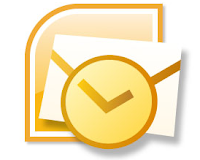 What I Used to Do
What I Used to DoWhen you delegate a task by e-mail, the other person is responsible for some action. However, you want some trigger to remind you, on a specific date, to see whether the person has delivered. Checking up is not difficult; it's the remembering to check up that's tricky.
I used a simple technique very effectively. When I would send an e-mail delegating action to someone else, I would blind-copy myself. In other words, I would add my own e-mail address to the "bcc" line. A copy of the e-mail would be delivered to my Inbox. I would be shown as the sender. Because I was using the "bcc" line rather than the "cc" line, the recipient would not know I had copied myself.
When I sent the e-mail, I could forget about it and immediately move onto something else. The bcc e-mail sitting in my Inbox served as a reminder. I would generally allow that e-mail to remain in my Inbox until the end of the day.
At the end of the day, my practice was to drag that e-mail to the Task button, amend the subject as needed, set a due date, and save the task. When that date arrived, I would be looking at an entry on my task list to followup with the person.
The system worked great, and it is one I would recommend to anyone. But, you see this section is entitled "What I Used to Do." If it worked so well, why did I stop? The answer is simple...I improved upon it with a technique which required only one keystroke.
The Rule I Created...Enter the Tilde (~)
The tilde sign (~) is located on the upper left of your keyboard next the the "1." It is a character used in Spanish, and it happened to be a character I never used. Therefore, I selected that key as the one to help me with the job of follow-up on mails. (If you do use the tilde, pick another symbol which you do not use.)
In Outlook, I created a Rule. (Tools>Rules and Alerts) as outlined below:
- Under the "Start from a blank rule" heading, I chose "Check messages after sending."
- Click "Next."
- When the next box asked, "Which condition(s) do you want to check?" I selected "with specific words in the body."
- At the bottom of the screen, Step 2 asked me to edit the rule description by clicking an underlined value. I clicked the "specific words" hyperlink.
- When the box box appeared, I put the tilde sign (~) in the blank and clicked "Add" and then "OK."
- When that box closed, I clicked "Next."
- The next box asks, "What do you want to do with the message?" I checked, "move a copy to the specified folder."
- At the bottom of the screen, I was prompted to "Edit the rule description." I clicked the "specified" link, and on the next screen clicked on the picture of the Inbox. I then clicked "Next."
- I was presented with a screen which said "Are there any exceptions?" For me, there are none, so I simply clicked "Next."
- The next box asks for a name for the rule. I called mine "Delegated," and then clicked "Finish."
- I have now been returned to the "Rules and Alerts" screen where I click "Apply" and then "OK."
Below, you see how the rule reads when I click the "Rules and Alerts" from the "Tools" menu:
What I Do Now
Because of the rule I created in Outlook, anytime I send an e-mail that has the tilde sign (~) somewhere in the body, a copy of that e-mail instantly goes to my Inbox. On a day-to-day basis, whenever I create an e-mail that is delegating some task to someone and I want to later followup on it, I simply put that little tilde sign somewhere in the bottom. Usually, I stick it below the signature line. One keystroke...that's all it takes! The result is the same as putting myself in the bcc line. I can now go to something else. A copy of the e-mail goes to my Inbox. Later, as I am handling the rest of my e-mail , I see that e-mail, drag it to Tasks, and make a decision about when I want to see it again. I set a due date, along with amending the subject line, and save.
One keystroke and nothing falls through the cracks. That's easy enough I will actually do it!

No comments:
Post a Comment